University Case Study: Mr. M. and Alzheimer's Disease Evaluation
VerifiedAdded on 2022/09/14
|6
|1623
|30
Case Study
AI Summary
This case study analyzes Mr. M., a 70-year-old male residing in an assisted living facility, who presents with clinical manifestations suggestive of Alzheimer's disease. The study examines the patient's health history, including hypertension, hypercholesterolemia, and current medications such as Lisinopril and Lipitor. The analysis focuses on Mr. M.'s deteriorating cognitive abilities, including memory loss, difficulty recalling names, and repeating information. The case study explores the primary and secondary diagnoses based on the patient's symptoms and the need for further medical evaluations. The physical, psychological, and family effects of the disease are discussed, along with interventions, including emotional support, Alzheimer's management education, and medication. Finally, the study identifies potential complications such as falls, medication side effects, and heart-related issues associated with Alzheimer's disease. The case study references multiple sources to support the analysis and conclusions.

1
Mr. M. case study
Student’s name
University
Date
Course
Mr. M. case study
Student’s name
University
Date
Course
Paraphrase This Document
Need a fresh take? Get an instant paraphrase of this document with our AI Paraphraser
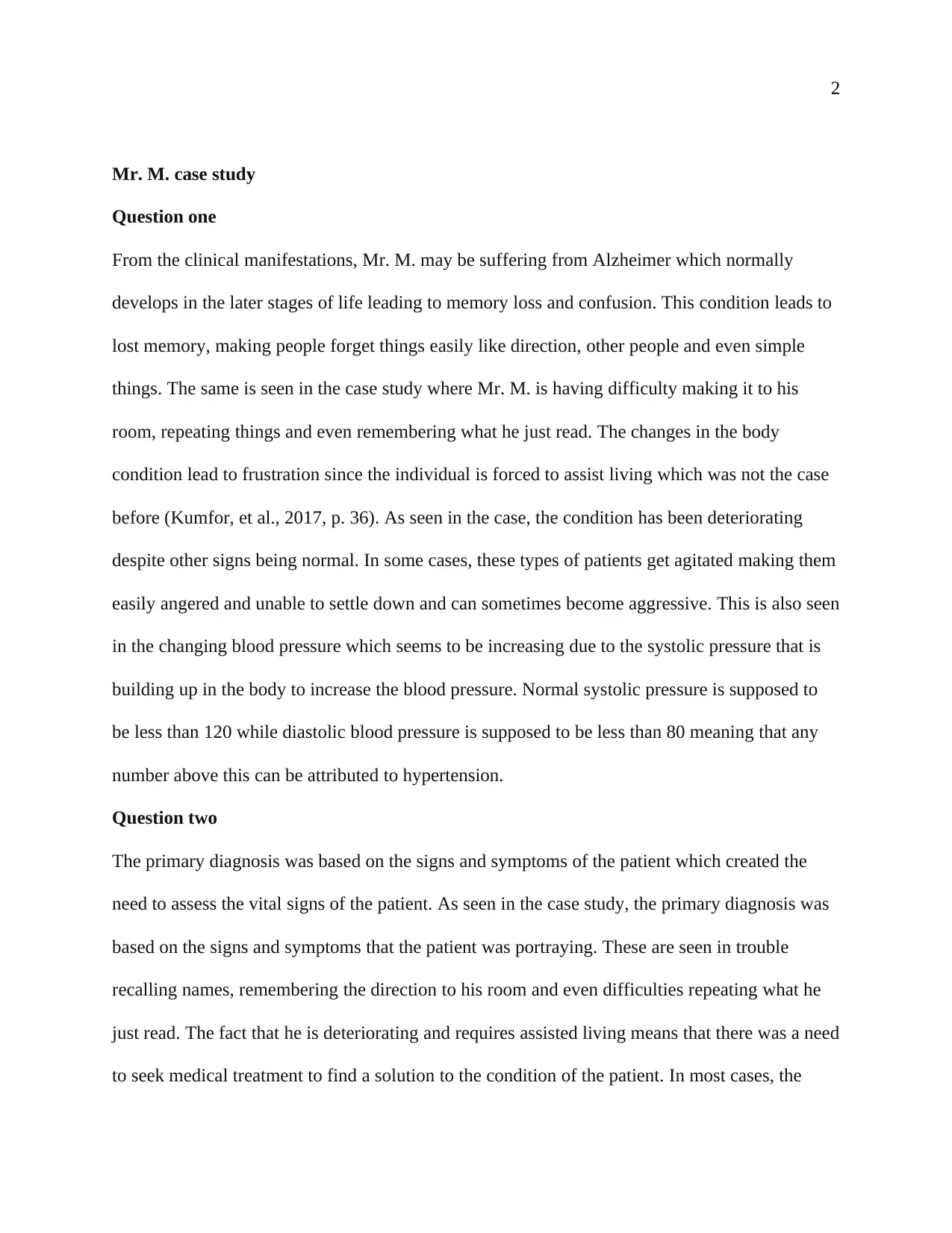
2
Mr. M. case study
Question one
From the clinical manifestations, Mr. M. may be suffering from Alzheimer which normally
develops in the later stages of life leading to memory loss and confusion. This condition leads to
lost memory, making people forget things easily like direction, other people and even simple
things. The same is seen in the case study where Mr. M. is having difficulty making it to his
room, repeating things and even remembering what he just read. The changes in the body
condition lead to frustration since the individual is forced to assist living which was not the case
before (Kumfor, et al., 2017, p. 36). As seen in the case, the condition has been deteriorating
despite other signs being normal. In some cases, these types of patients get agitated making them
easily angered and unable to settle down and can sometimes become aggressive. This is also seen
in the changing blood pressure which seems to be increasing due to the systolic pressure that is
building up in the body to increase the blood pressure. Normal systolic pressure is supposed to
be less than 120 while diastolic blood pressure is supposed to be less than 80 meaning that any
number above this can be attributed to hypertension.
Question two
The primary diagnosis was based on the signs and symptoms of the patient which created the
need to assess the vital signs of the patient. As seen in the case study, the primary diagnosis was
based on the signs and symptoms that the patient was portraying. These are seen in trouble
recalling names, remembering the direction to his room and even difficulties repeating what he
just read. The fact that he is deteriorating and requires assisted living means that there was a need
to seek medical treatment to find a solution to the condition of the patient. In most cases, the
Mr. M. case study
Question one
From the clinical manifestations, Mr. M. may be suffering from Alzheimer which normally
develops in the later stages of life leading to memory loss and confusion. This condition leads to
lost memory, making people forget things easily like direction, other people and even simple
things. The same is seen in the case study where Mr. M. is having difficulty making it to his
room, repeating things and even remembering what he just read. The changes in the body
condition lead to frustration since the individual is forced to assist living which was not the case
before (Kumfor, et al., 2017, p. 36). As seen in the case, the condition has been deteriorating
despite other signs being normal. In some cases, these types of patients get agitated making them
easily angered and unable to settle down and can sometimes become aggressive. This is also seen
in the changing blood pressure which seems to be increasing due to the systolic pressure that is
building up in the body to increase the blood pressure. Normal systolic pressure is supposed to
be less than 120 while diastolic blood pressure is supposed to be less than 80 meaning that any
number above this can be attributed to hypertension.
Question two
The primary diagnosis was based on the signs and symptoms of the patient which created the
need to assess the vital signs of the patient. As seen in the case study, the primary diagnosis was
based on the signs and symptoms that the patient was portraying. These are seen in trouble
recalling names, remembering the direction to his room and even difficulties repeating what he
just read. The fact that he is deteriorating and requires assisted living means that there was a need
to seek medical treatment to find a solution to the condition of the patient. In most cases, the
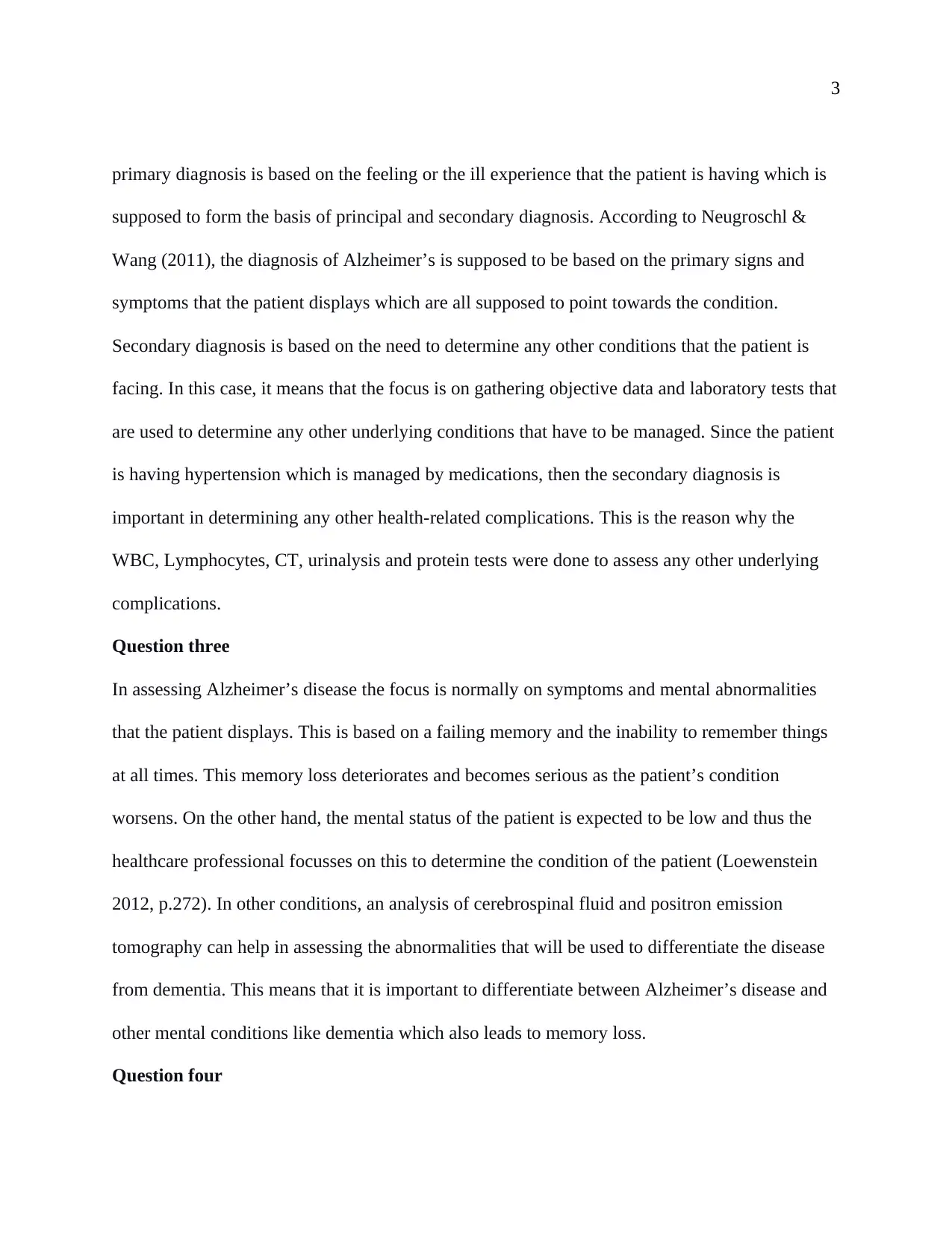
3
primary diagnosis is based on the feeling or the ill experience that the patient is having which is
supposed to form the basis of principal and secondary diagnosis. According to Neugroschl &
Wang (2011), the diagnosis of Alzheimer’s is supposed to be based on the primary signs and
symptoms that the patient displays which are all supposed to point towards the condition.
Secondary diagnosis is based on the need to determine any other conditions that the patient is
facing. In this case, it means that the focus is on gathering objective data and laboratory tests that
are used to determine any other underlying conditions that have to be managed. Since the patient
is having hypertension which is managed by medications, then the secondary diagnosis is
important in determining any other health-related complications. This is the reason why the
WBC, Lymphocytes, CT, urinalysis and protein tests were done to assess any other underlying
complications.
Question three
In assessing Alzheimer’s disease the focus is normally on symptoms and mental abnormalities
that the patient displays. This is based on a failing memory and the inability to remember things
at all times. This memory loss deteriorates and becomes serious as the patient’s condition
worsens. On the other hand, the mental status of the patient is expected to be low and thus the
healthcare professional focusses on this to determine the condition of the patient (Loewenstein
2012, p.272). In other conditions, an analysis of cerebrospinal fluid and positron emission
tomography can help in assessing the abnormalities that will be used to differentiate the disease
from dementia. This means that it is important to differentiate between Alzheimer’s disease and
other mental conditions like dementia which also leads to memory loss.
Question four
primary diagnosis is based on the feeling or the ill experience that the patient is having which is
supposed to form the basis of principal and secondary diagnosis. According to Neugroschl &
Wang (2011), the diagnosis of Alzheimer’s is supposed to be based on the primary signs and
symptoms that the patient displays which are all supposed to point towards the condition.
Secondary diagnosis is based on the need to determine any other conditions that the patient is
facing. In this case, it means that the focus is on gathering objective data and laboratory tests that
are used to determine any other underlying conditions that have to be managed. Since the patient
is having hypertension which is managed by medications, then the secondary diagnosis is
important in determining any other health-related complications. This is the reason why the
WBC, Lymphocytes, CT, urinalysis and protein tests were done to assess any other underlying
complications.
Question three
In assessing Alzheimer’s disease the focus is normally on symptoms and mental abnormalities
that the patient displays. This is based on a failing memory and the inability to remember things
at all times. This memory loss deteriorates and becomes serious as the patient’s condition
worsens. On the other hand, the mental status of the patient is expected to be low and thus the
healthcare professional focusses on this to determine the condition of the patient (Loewenstein
2012, p.272). In other conditions, an analysis of cerebrospinal fluid and positron emission
tomography can help in assessing the abnormalities that will be used to differentiate the disease
from dementia. This means that it is important to differentiate between Alzheimer’s disease and
other mental conditions like dementia which also leads to memory loss.
Question four
⊘ This is a preview!⊘
Do you want full access?
Subscribe today to unlock all pages.

Trusted by 1+ million students worldwide
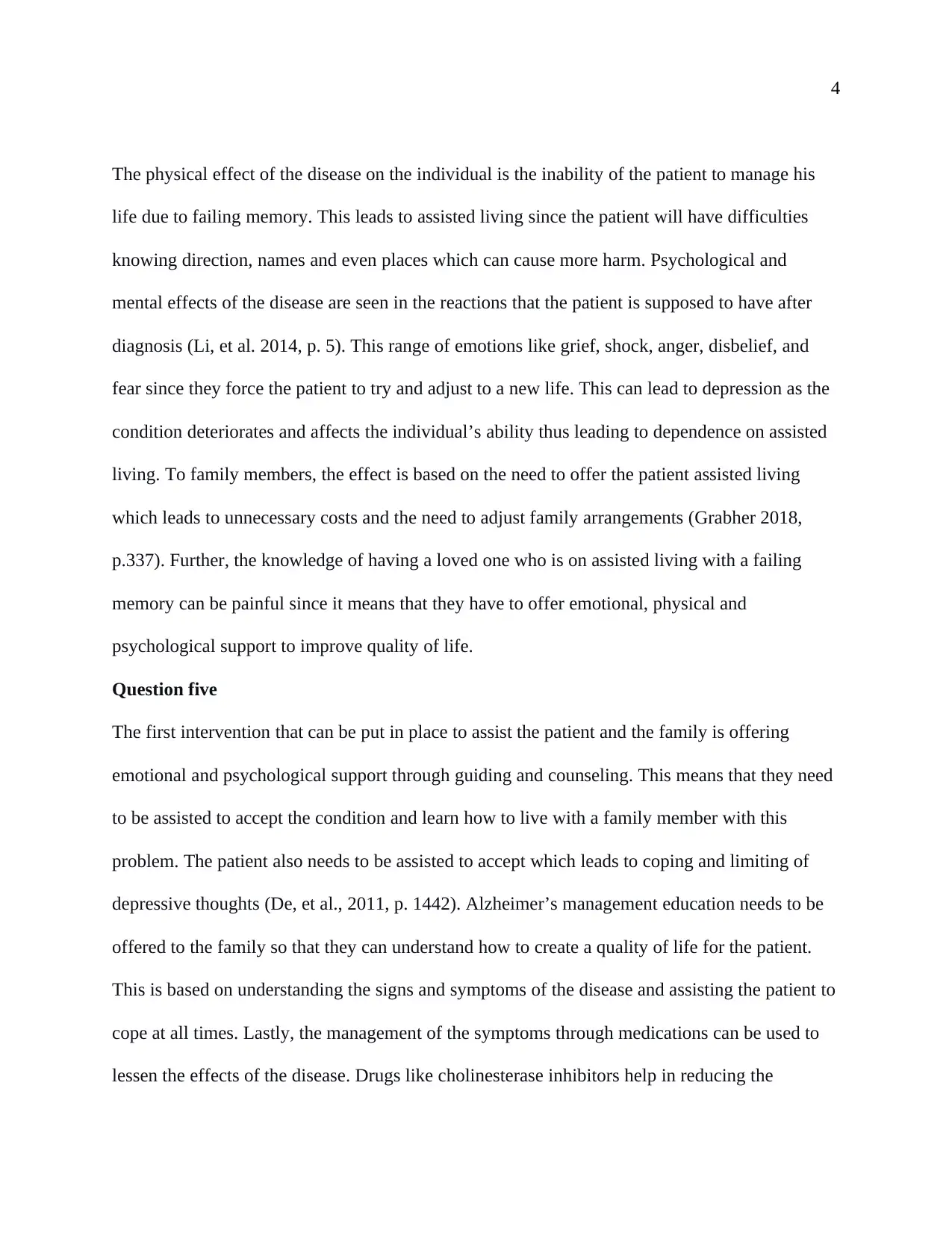
4
The physical effect of the disease on the individual is the inability of the patient to manage his
life due to failing memory. This leads to assisted living since the patient will have difficulties
knowing direction, names and even places which can cause more harm. Psychological and
mental effects of the disease are seen in the reactions that the patient is supposed to have after
diagnosis (Li, et al. 2014, p. 5). This range of emotions like grief, shock, anger, disbelief, and
fear since they force the patient to try and adjust to a new life. This can lead to depression as the
condition deteriorates and affects the individual’s ability thus leading to dependence on assisted
living. To family members, the effect is based on the need to offer the patient assisted living
which leads to unnecessary costs and the need to adjust family arrangements (Grabher 2018,
p.337). Further, the knowledge of having a loved one who is on assisted living with a failing
memory can be painful since it means that they have to offer emotional, physical and
psychological support to improve quality of life.
Question five
The first intervention that can be put in place to assist the patient and the family is offering
emotional and psychological support through guiding and counseling. This means that they need
to be assisted to accept the condition and learn how to live with a family member with this
problem. The patient also needs to be assisted to accept which leads to coping and limiting of
depressive thoughts (De, et al., 2011, p. 1442). Alzheimer’s management education needs to be
offered to the family so that they can understand how to create a quality of life for the patient.
This is based on understanding the signs and symptoms of the disease and assisting the patient to
cope at all times. Lastly, the management of the symptoms through medications can be used to
lessen the effects of the disease. Drugs like cholinesterase inhibitors help in reducing the
The physical effect of the disease on the individual is the inability of the patient to manage his
life due to failing memory. This leads to assisted living since the patient will have difficulties
knowing direction, names and even places which can cause more harm. Psychological and
mental effects of the disease are seen in the reactions that the patient is supposed to have after
diagnosis (Li, et al. 2014, p. 5). This range of emotions like grief, shock, anger, disbelief, and
fear since they force the patient to try and adjust to a new life. This can lead to depression as the
condition deteriorates and affects the individual’s ability thus leading to dependence on assisted
living. To family members, the effect is based on the need to offer the patient assisted living
which leads to unnecessary costs and the need to adjust family arrangements (Grabher 2018,
p.337). Further, the knowledge of having a loved one who is on assisted living with a failing
memory can be painful since it means that they have to offer emotional, physical and
psychological support to improve quality of life.
Question five
The first intervention that can be put in place to assist the patient and the family is offering
emotional and psychological support through guiding and counseling. This means that they need
to be assisted to accept the condition and learn how to live with a family member with this
problem. The patient also needs to be assisted to accept which leads to coping and limiting of
depressive thoughts (De, et al., 2011, p. 1442). Alzheimer’s management education needs to be
offered to the family so that they can understand how to create a quality of life for the patient.
This is based on understanding the signs and symptoms of the disease and assisting the patient to
cope at all times. Lastly, the management of the symptoms through medications can be used to
lessen the effects of the disease. Drugs like cholinesterase inhibitors help in reducing the
Paraphrase This Document
Need a fresh take? Get an instant paraphrase of this document with our AI Paraphraser
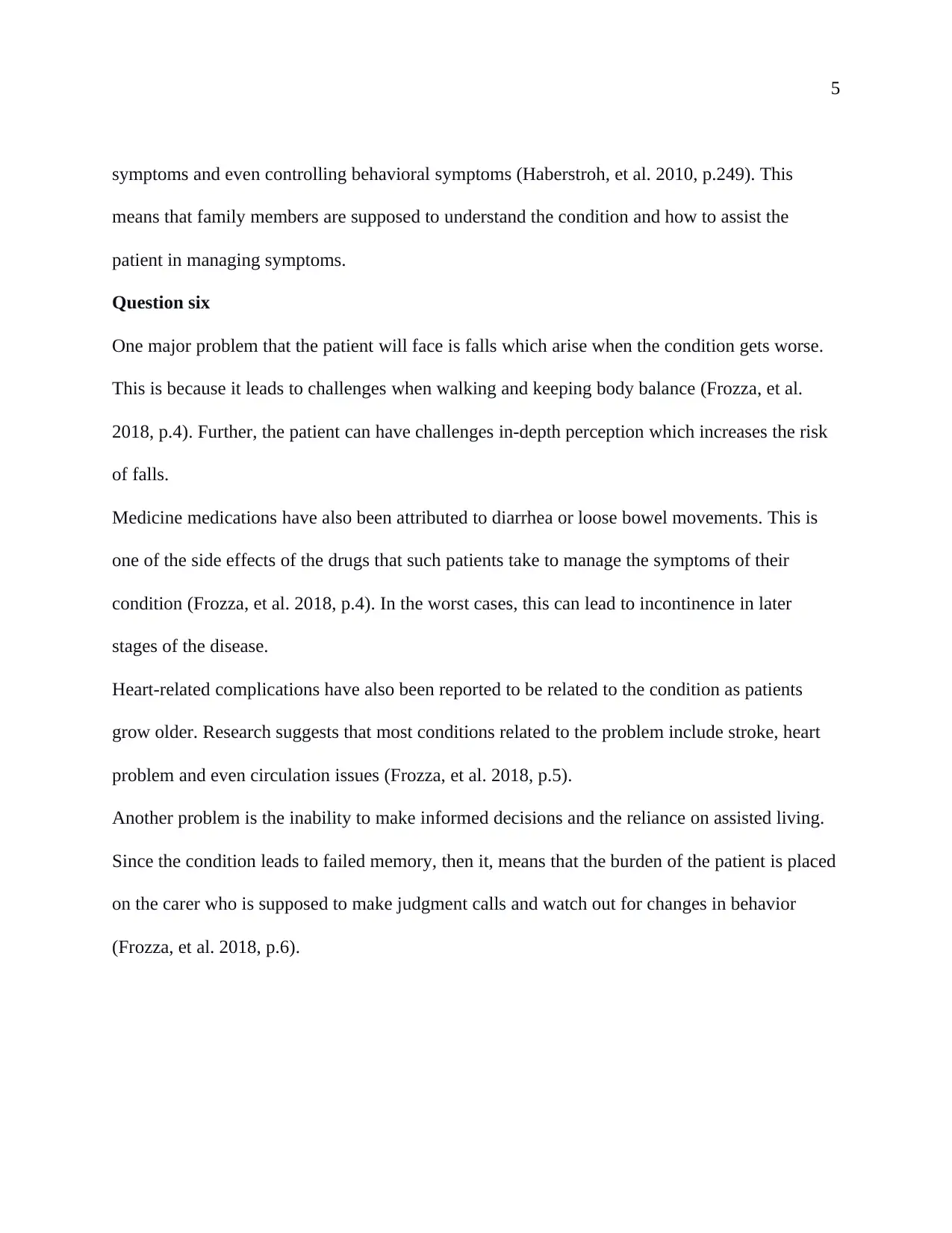
5
symptoms and even controlling behavioral symptoms (Haberstroh, et al. 2010, p.249). This
means that family members are supposed to understand the condition and how to assist the
patient in managing symptoms.
Question six
One major problem that the patient will face is falls which arise when the condition gets worse.
This is because it leads to challenges when walking and keeping body balance (Frozza, et al.
2018, p.4). Further, the patient can have challenges in-depth perception which increases the risk
of falls.
Medicine medications have also been attributed to diarrhea or loose bowel movements. This is
one of the side effects of the drugs that such patients take to manage the symptoms of their
condition (Frozza, et al. 2018, p.4). In the worst cases, this can lead to incontinence in later
stages of the disease.
Heart-related complications have also been reported to be related to the condition as patients
grow older. Research suggests that most conditions related to the problem include stroke, heart
problem and even circulation issues (Frozza, et al. 2018, p.5).
Another problem is the inability to make informed decisions and the reliance on assisted living.
Since the condition leads to failed memory, then it, means that the burden of the patient is placed
on the carer who is supposed to make judgment calls and watch out for changes in behavior
(Frozza, et al. 2018, p.6).
symptoms and even controlling behavioral symptoms (Haberstroh, et al. 2010, p.249). This
means that family members are supposed to understand the condition and how to assist the
patient in managing symptoms.
Question six
One major problem that the patient will face is falls which arise when the condition gets worse.
This is because it leads to challenges when walking and keeping body balance (Frozza, et al.
2018, p.4). Further, the patient can have challenges in-depth perception which increases the risk
of falls.
Medicine medications have also been attributed to diarrhea or loose bowel movements. This is
one of the side effects of the drugs that such patients take to manage the symptoms of their
condition (Frozza, et al. 2018, p.4). In the worst cases, this can lead to incontinence in later
stages of the disease.
Heart-related complications have also been reported to be related to the condition as patients
grow older. Research suggests that most conditions related to the problem include stroke, heart
problem and even circulation issues (Frozza, et al. 2018, p.5).
Another problem is the inability to make informed decisions and the reliance on assisted living.
Since the condition leads to failed memory, then it, means that the burden of the patient is placed
on the carer who is supposed to make judgment calls and watch out for changes in behavior
(Frozza, et al. 2018, p.6).
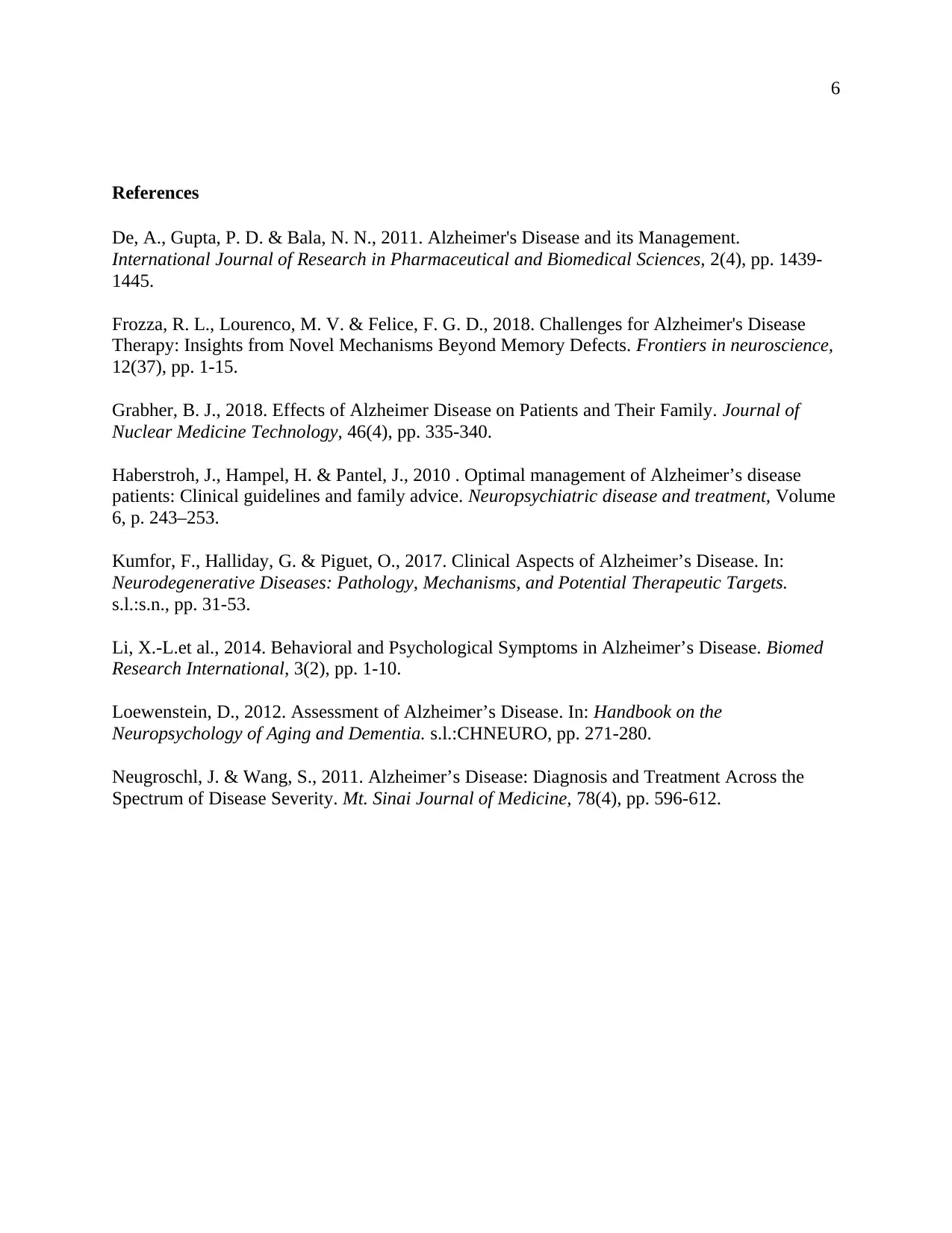
6
References
De, A., Gupta, P. D. & Bala, N. N., 2011. Alzheimer's Disease and its Management.
International Journal of Research in Pharmaceutical and Biomedical Sciences, 2(4), pp. 1439-
1445.
Frozza, R. L., Lourenco, M. V. & Felice, F. G. D., 2018. Challenges for Alzheimer's Disease
Therapy: Insights from Novel Mechanisms Beyond Memory Defects. Frontiers in neuroscience,
12(37), pp. 1-15.
Grabher, B. J., 2018. Effects of Alzheimer Disease on Patients and Their Family. Journal of
Nuclear Medicine Technology, 46(4), pp. 335-340.
Haberstroh, J., Hampel, H. & Pantel, J., 2010 . Optimal management of Alzheimer’s disease
patients: Clinical guidelines and family advice. Neuropsychiatric disease and treatment, Volume
6, p. 243–253.
Kumfor, F., Halliday, G. & Piguet, O., 2017. Clinical Aspects of Alzheimer’s Disease. In:
Neurodegenerative Diseases: Pathology, Mechanisms, and Potential Therapeutic Targets.
s.l.:s.n., pp. 31-53.
Li, X.-L.et al., 2014. Behavioral and Psychological Symptoms in Alzheimer’s Disease. Biomed
Research International, 3(2), pp. 1-10.
Loewenstein, D., 2012. Assessment of Alzheimer’s Disease. In: Handbook on the
Neuropsychology of Aging and Dementia. s.l.:CHNEURO, pp. 271-280.
Neugroschl, J. & Wang, S., 2011. Alzheimer’s Disease: Diagnosis and Treatment Across the
Spectrum of Disease Severity. Mt. Sinai Journal of Medicine, 78(4), pp. 596-612.
References
De, A., Gupta, P. D. & Bala, N. N., 2011. Alzheimer's Disease and its Management.
International Journal of Research in Pharmaceutical and Biomedical Sciences, 2(4), pp. 1439-
1445.
Frozza, R. L., Lourenco, M. V. & Felice, F. G. D., 2018. Challenges for Alzheimer's Disease
Therapy: Insights from Novel Mechanisms Beyond Memory Defects. Frontiers in neuroscience,
12(37), pp. 1-15.
Grabher, B. J., 2018. Effects of Alzheimer Disease on Patients and Their Family. Journal of
Nuclear Medicine Technology, 46(4), pp. 335-340.
Haberstroh, J., Hampel, H. & Pantel, J., 2010 . Optimal management of Alzheimer’s disease
patients: Clinical guidelines and family advice. Neuropsychiatric disease and treatment, Volume
6, p. 243–253.
Kumfor, F., Halliday, G. & Piguet, O., 2017. Clinical Aspects of Alzheimer’s Disease. In:
Neurodegenerative Diseases: Pathology, Mechanisms, and Potential Therapeutic Targets.
s.l.:s.n., pp. 31-53.
Li, X.-L.et al., 2014. Behavioral and Psychological Symptoms in Alzheimer’s Disease. Biomed
Research International, 3(2), pp. 1-10.
Loewenstein, D., 2012. Assessment of Alzheimer’s Disease. In: Handbook on the
Neuropsychology of Aging and Dementia. s.l.:CHNEURO, pp. 271-280.
Neugroschl, J. & Wang, S., 2011. Alzheimer’s Disease: Diagnosis and Treatment Across the
Spectrum of Disease Severity. Mt. Sinai Journal of Medicine, 78(4), pp. 596-612.
⊘ This is a preview!⊘
Do you want full access?
Subscribe today to unlock all pages.

Trusted by 1+ million students worldwide
1 out of 6
Related Documents
Your All-in-One AI-Powered Toolkit for Academic Success.
+13062052269
info@desklib.com
Available 24*7 on WhatsApp / Email
![[object Object]](/_next/static/media/star-bottom.7253800d.svg)
Unlock your academic potential
Copyright © 2020–2025 A2Z Services. All Rights Reserved. Developed and managed by ZUCOL.





